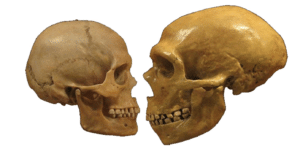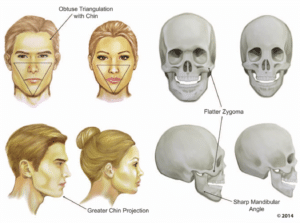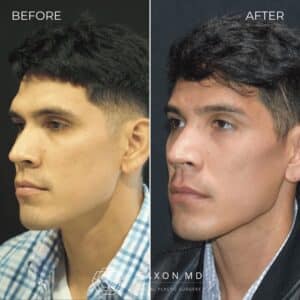The “Neanderthal brow” is a term often used to describe a prominent, protruding forehead. This characteristic can be traced back to our ancient ancestors, the Neanderthals, who had a distinctively robust facial structure. Though modern humans (Homo sapiens) and Neanderthals interbred, the development of the skull and the presence of a “caveman forehead” differ significantly between these two species.
In this post, we’ll explore the origins of a protruding forehead in adults, how it relates to the Neanderthal brow ridge, and the options available today to address this prominent facial feature.
Differences Between Neanderthal and Homo Sapien Skull Shape
Neanderthals, who lived between 400,000 and 40,000 years ago, are well-known for their heavy brow ridges and low, sloping foreheads. Their skulls were generally more robust and elongated than those of modern Homo sapiens, with thick bones that contributed to a strong, prominent brow ridge. This “caveman” look is commonly associated with their need for a durable skull structure to support large chewing muscles, as well as a lifestyle involving close-range hunting and physical endurance.
In contrast, Homo sapiens evolved with flatter foreheads and a reduced brow ridge. Our skulls are more rounded and less heavily built, allowing for a larger cranial capacity and the development of more advanced brain functions. One crucial difference between Homo sapiens and Neanderthals lies in the expressiveness of the forehead.

The Advantage of Smaller Foreheads in Homo Sapiens
A smaller forehead in Homo sapiens is thought to have facilitated better social communication. With a reduced brow ridge, our species gained greater flexibility in facial expressions, particularly in the brow region. Eyebrow positioning and movement play a key role in nonverbal communication, allowing humans to convey a wide range of emotions, from surprise and empathy to skepticism and joy. This expressiveness helped early Homo sapiens form stronger social bonds, which was advantageous for survival in group-oriented societies.
As Neanderthals had a more rigid facial structure, their ability to use their eyebrows for nuanced expression may have been limited. This difference in facial communication could have been one factor that gave Homo sapiens a competitive edge in evolving complex social networks and collaborative strategies.
Interbreeding and Neanderthal DNA in Modern Humans
Though Neanderthals are now extinct, they did not completely disappear from the human genetic line. There is significant evidence that Homo sapiens and Neanderthals interbred during periods when their populations overlapped, particularly in Europe and Asia. As a result, most non-African humans today carry between 1-2% Neanderthal DNA. This genetic legacy can influence various physical traits, including skin tone, hair texture, and even the presence of a prominent brow ridge in some individuals.
While a “caveman forehead” might not be as pronounced as it was in our Neanderthal ancestors, certain facial features, such as a protruding forehead or thick brow ridge, can still be passed down through these ancient genetic connections.
Development of the Forehead: Frontal Bone and Frontal Sinus
The shape of the forehead is largely determined by the frontal bone and the frontal sinus. The frontal bone forms the forehead and part of the eye sockets, while the frontal sinus, located just behind the brow ridge, develops during childhood and adolescence. The size and shape of the frontal sinus can vary greatly between individuals and contributes to the overall contour of the forehead. In people with a prominent brow ridge, the frontal bone and sinus can protrude forward, giving the appearance of a “caveman” or Neanderthal-like forehead.
Testosterone and Differences in Forehead Shape
Testosterone plays a critical role in shaping the forehead, especially in men. High levels of this hormone during puberty and early adulthood cause the development of thicker, more robust bones, including a pronounced brow ridge. This is why men typically have more prominent foreheads compared to women. The frontal sinus also tends to be larger in men, further contributing to the characteristic “heavy brow” appearance seen in some individuals.

Brow Bone Reduction: A Solution for a Protruding Forehead
For those with a prominent brow ridge who feel self-conscious about their appearance, brow bone reduction surgery offers an effective solution. This procedure, also known as forehead contouring or reduction, involves reshaping the frontal bone to create a flatter, smoother appearance.
During the surgery, the surgeon carefully removes or reshapes the bone in the brow ridge to reduce its prominence. Depending on the patient’s anatomy, the frontal sinus may also be addressed to achieve the desired contour. In some cases, brow bone reduction is combined with a brow lift to enhance the overall results, creating a more balanced and youthful facial appearance.

Brow bone reduction can benefit individuals with a naturally prominent brow ridge or those with residual Neanderthal-like features. By softening the appearance of the forehead, this procedure can lead to a more harmonious facial profile, improved self-confidence, and a look that aligns with modern aesthetic standards.
Conclusion
The “Neanderthal brow ridge” may be a relic of our ancient past, but it continues to influence the facial structure of some modern humans. Understanding the evolutionary origins of a protruding forehead provides insight into why certain features, like the caveman forehead, persist today. While these features once served practical purposes for our ancestors, they may not align with current aesthetic preferences. Thankfully, advances in plastic surgery, such as brow bone reduction, offer solutions for those who wish to soften the appearance of their forehead and achieve a more refined look.
If you’re concerned about a prominent brow ridge, brow bone reduction may be the right option for you, providing long-lasting results and helping you feel more confident in your appearance.
You May Also Like:
- Can Men Get A Brow Bone Reduction? Correcting a Prominent Brow Ridge
- Why Do People Keep Telling Me I Look Like a Man?
- Facial Feminization in Cisgender Women: A Paradigm Shift in Facial Rejuvenation
- Brow Bone Reduction Before and After